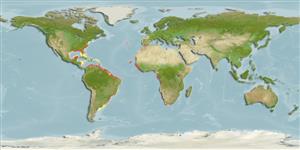Common names from other countries
ກຸ່ມປາກະດູກອ່ອນ (ເຊັ່ນ: ປາສະຫລາມ, ປາຜາໄລ) (sharks and rays) >
Myliobatiformes (Stingrays) >
Gymnuridae (Butterfly rays)
Etymology: Gymnura: Greek, gymnos = naked + Greek, oura = tail (Ref. 45335).
More on authors: Bloch & Schneider.
Issue
Species complex include Gymnura lessae and
Gymnura sereti; distribution of and both species were included for Gymnura micrura. Distribution will be corrected.
Environment: milieu / climate zone / depth range / distribution range
ນິເວດວິທະຍາ
ສັດທະເລ; ນ້ຳກ່ອຍ ອາໄສຢູ່ໃກ້ໜ້າດິນໃຕ້ພື້ນທ້ອງນ້ຳ; ລະດັບຄວາມເລິກ ? - 55 m (Ref. 27549). Deep-water
Southwestern Atlantic: Venezuela, including Trinidad and Tobago, to Brazil (Rio de Janeiro).
Length at first maturity / ຂະໜາດ / ນ້ຳໜັກ / Age
Maturity: Lm 35.0, range 34 - 50 cm
Max length : 137 cm WD ຕົວຜູ້/ບໍ່ມີເພດ; (Ref. 4439); common length : 90.0 cm WD ຕົວຜູ້/ບໍ່ມີເພດ; (Ref. 5217); ນ້ຳໜັກສູງສຸດທີ່ເຄຍຈັດພີມມາ: 0.00 g
Broad, diamond-shaped ray with a very short tail lacking a dorsal spine (Ref. 26938). Snout protruding. Front edges of disk concave. Tail with low dorsal and ventral finfolds and 3 - 4 dark crossbars (Ref. 7251). Upper surface gray, brown, light green or purple with round spots. Lower surface white (Ref. 6902).
Prefers neritic waters of the continental shelf and
usually found on soft bottoms. May enter brackish
estuaries or hyper-saline lagoons (Ref. 5217). Feeds on
fish and shrimps (Ref. 28587); other crustaceans and clams
(Ref. 27549). Ovoviviparous (Ref. 50449). Generally
marketed salted (Ref. 5217).
Exhibit ovoviparity (aplacental viviparity), with embryos feeding initially on yolk, then receiving additional nourishment from the mother by indirect absorption of uterine fluid enriched with mucus, fat or protein through specialised structures (Ref. 50449). Distinct pairing with embrace (Ref. 205).
Yokota, L. and M.R. de Carvalho, 2017. Taxonomic and morphological revision of butterfly rays of Gymnura micrura (Bloch & Schneider, 1801) species complex, with the description of two new species (Myliobatiformes: Gymnuridae). Zootaxa 4332(1):1-74. (Ref. 116399)
IUCN Red List Status (Ref. 130435)
CITES (Ref. 128078)
Not Evaluated
Threat to humans
Harmless
Human uses
ການປະມົງ: ທີ່ເປັນການຄ້າໜ້ອຍ
ເຄື່ອງມື
Special reports
Download XML
ແຫຼ່ງອີນເຕີເນັດ
Estimates based on models
Preferred temperature (Ref.
115969): 21.8 - 27.9, mean 25 (based on 544 cells).
Phylogenetic diversity index (Ref.
82804): PD
50 = 0.5000 [Uniqueness, from 0.5 = low to 2.0 = high].
Bayesian length-weight: a=0.00513 (0.00312 - 0.00843), b=3.10 (2.95 - 3.25), in cm Total Length, based on LWR estimates for this species & (Sub)family-body (Ref.
93245).
ຊັ້ນເຂດຮ້ອນ (Ref.
69278): 3.6 ±0.53 se; based on food items.
ຄວາມຢືດຢຸ່ນ (Ref.
120179): ຕຳ່ຫຼາຍ, ປະຊາກອນຕຳ່ສຸດທີ່ໃຊ້ເວລາສອງເທົ່າຫຼາຍກວ່າ 14 ປີ (Fec=3).
Fishing Vulnerability (Ref.
59153): Moderate to high vulnerability (51 of 100).
